Today I thought I'd share a video from Florence + The Machine. My husband actually made me sit down and watch the video because he noticed all the mythological and Pre-Raphaelite references! We first encountered Florence + The Machine while watching the Colbert Report, and our first reaction (other than noticing that she had a great voice), was that she looked like she'd fallen out of a Pre-Raphaelite painting. Apparently this is no coincidence, and you'll notice that most of her videos contain references to the Pre-Raphaelites, though the video for "Rabbit Heart" is one of the most overt. From the minute you see the water behind her you can tell this is going to end in a send-up of the Lady of Shalott!
For an even heavier dose of the Lady of Shalott, check out The Band Perry's "If I Die Young". My daughter actually discovered this one on Vevo the other day!
Someone from the band is clearly a big fan of the Pre-Raphaelites! Of course Lady of Shalott is the most obvious reference (the video actually closes with a shot of Tennyson's poem), but I thought the scene at :38 (with the mother at the window) was a little evocative of John Everett Millais' Mariana. It's a very well done video, and the song is beautiful as well.
Tuesday, July 26, 2011
Florence + The Machine, The Band Perry and the Lady of Shalott in Music Videos
Posted by
Margaret
at
4:09 PM
5
comments
![]()
![]()
Labels: millais, music, mythology, pre-raphaelites
Friday, January 7, 2011
The Poetry of Drawing: Pre-Raphaelite Designs, Studies and Watercolours
The Poetry of Drawing will include pieces from the most prominent members of the Pre-Raphaelite movement, including all the original members of the PRB, Elizabeth Siddal, Edward Burne-Jones, Frederick Sandys and Simeon Solomon. Later artists, such as Aubrey Beardsley, who were influenced by the Brotherhood are also included, as are the Arts and Crafts contributions of William Morris, William de Morgan and Florence Camm.
For those of you who are unable to attend, the exhibition's curator has created an illustrated volume entitled Pre-Raphaelite Drawing. The book will be published by Thames and Hudson. I would love to see this exhibit in person, but if I don't get the chance, I will definitely be looking into the catalogue!
For more information and ticket prices, please visit the Birmingham Museum's exhibition website.
Image above is William Morris' sketch for his Trellis wallpaper design.
Posted by
Margaret
at
3:13 PM
4
comments
![]()
![]()
Labels: edward burne-jones, frederick sandys, lizzie siddal, millais, museums, news, pre-raphaelites, rossetti, william holman hunt, william morris
Tuesday, August 17, 2010
Rare Millais Sketches Found in Led Zeppelin Record Sleeves
Former Led Zeppelin guitarist Jimmy Page is one of the world's best known collectors of Pre-Raphaelite art. But he nearly lost a handsome stash of sketches by John Everett Millais as the result of what appears to be an auction house mix-up.
Posted by
Margaret
at
2:56 PM
9
comments
![]()
![]()
Labels: millais, music, news, poetry, pre-raphaelites
Thursday, February 4, 2010
The Rejection of Cain's Sacrifice

I've been very busy with my little girl over the past few weeks. She's an absolute delight! Even though she's only three months old, I've been having a lot of fun reading with her. Before she was born, my husband and I bought a copy of Tomie dePaola's Book of Bible Stories. It has fantastic pictures that really capture her interest (and the stories are short, so she doesn't have trouble staying focused). At any rate, the other day I read her the story of Cain and Abel. Yikes! It's easy to forget how gory some of these stories were! I was sort of glad that she was too little to have any idea what it was about. Nevertheless, I found myself trying to explain to my infant why people do mean things, though I had a bit tougher time telling her why God was not that impressed with Cain's vegetarian sacrifice. Welcome to motherhood, I suppose! What happens when she can actually ask questions?
Anyway, today I came across this 1842 sketch by John Millais of the Rejection of Cain's Sacrifice. Millais was just 13 years old when he produced this! Even at this early age, you can see the talent Millais possessed. I love how he's drawn Cain's cloak blowing in the wind and the smoke billowing up towards heaven (notice the pious looking Abel in the background). You can see a lot more of the details in the painting if you visit it at the Birmingham Art Gallery's online gallery. Be sure to check it out!
Posted by
Margaret
at
12:50 PM
3
comments
![]()
![]()
Labels: millais, pre-raphaelites
Tuesday, August 25, 2009
Victorian Art on Display at Brigham Young University Museum of Art
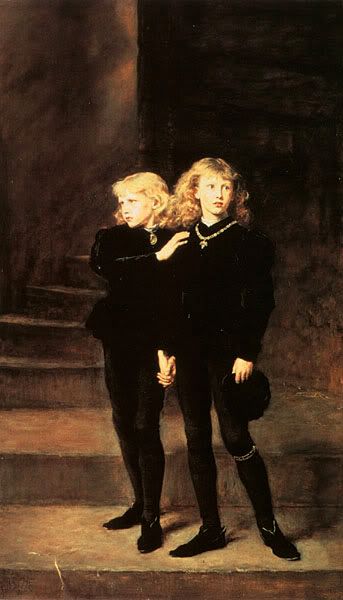
Brigham Young University Museum of Art is currently hosting an exhibit of Victorian-era artworks from the Royal Holloway collection entitled Paintings from the Reign of Victoria: The Royal Holloway Collection, London . Pre-Raphaelite John Everett Millais' 1878 painting The Two Princes Edward and Richard in the Tower, 1483 (shown above) is among the works on display.
The exhibition will run from August 14-October 24, 2009, and is a must see for anyone in the area. Admission to the exhibit is free of charge. You can even organize a free docent-led tour of the exhibit by calling the Museum Education Department at 801-422-1140. You can also check out Brigham Young University Museum of Art's sepcial Royal Holloway exhibit website for more background information on the event. (It's a great resource, especially if you aren't able to make it to the exhibit).
image courtesy Wikimedia commons.
Posted by
Margaret
at
8:34 AM
4
comments
![]()
![]()
Monday, August 10, 2009
BBC 4 The Pre Raphaelites
For those of you living in the UK, the BBC has released a 3-part documentary series on the Pre-Raphaelites to coincide with Desperate Romantics. Since Desperate Romantics is rather short on historical context, be sure to watch the documentary alongside the costume drama, especially if this is your first introduction to the Pre-Raphaelites. 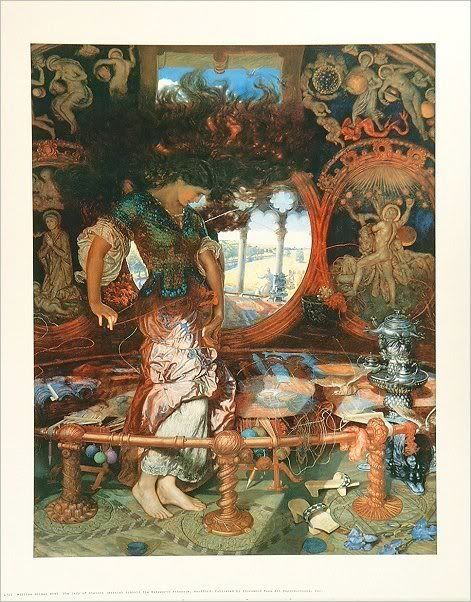
The documentary, entitled The Pre-Raphaelites: Victorian Revolutionaries, features author Jan Marsh (author of Pre-Raphaelite Sisterhood) and a number of other art historians discussing the PRB's rise to fame, their landscape art and the eventual commercialisation of their work.
I really enjoyed the series, although I found it a little annoying that they kept insisting that the Pre Raphaelite Brotherhood somehow "sold out" when they began to find a market for their art. The series really pushes the notion that the Pre-Raphaelites were somehow the first artists to commercialise their work (and that this was a betrayal of their earlier, nobler ideals). Artists and writers have always wanted to profit from their work. It's pure romantic fantasy to imagine that there was some golden age of art where everyone indulged in art for art's sake without an eye toward profits. The PRB simply lucked out by being in the right place at the right time, and they took advantage of the technology that was available to them. I'm quite sure that if Sir Joshua Reynolds had lived through the Victorian era, he too would have been hawking his lithographs right alongside the former members of the PRB. You will remember that even the socialist William Morris was a businessman! It seems very hard for the BBC to conceive of the possibility that one might simultaneously be a romantic revolutionary and hope to pay the rent.
For those of you living in the UK, several of the episodes are available in streaming video online through the BBC Pre-Raphaelites mini site.
Episode 2, which covers the Pre-Raphaelites approach to landscape art, will be aired again on August 11 at 10:00 pm.
Posted by
Margaret
at
8:24 AM
7
comments
![]()
![]()
Labels: millais, news, pre-raphaelites, reviews, rossetti, william holman hunt, william morris
Monday, August 3, 2009
Desperate Romantics - First Impressions
I finally had a chance to watch the first two episodes of BBC's Desperate Romantics with Javier last week. We both really enjoyed it. Overall, I found it highly entertaining (and yes, it was quite accurately described by its producer as "Entourage with easels"). The production was a bit weak on the historical front, but I suppose this was done by the writers to broaden the appeal of the series.
The series focuses on the early years of the Pre-Raphaelite Brotherhood and follows their rise to fame.
I was pleasantly surprised with the casting, particularly that of Lizzie Siddal. The actress who plays Lizzie not only resembles Siddal a great deal, but she also does an excellent job of bringing life and pathos to the character. John and Effie Ruskin are also well-cast, and are more developed than I had anticipated, although the endless speculation about what was wrong with their marriage always gets to me--honestly, nobody has any idea what the problem was (biographers seem to constantly return to the idea that Ruskin was disgusted by Effie's body hair, but how could they know?). Nevertheless, much like the rumours about Michael Jackson, I suppose this gossip is just too juicy for scriptwriters to pass up.
Unfortunately, the characterization of most of the other major players is rather simplistic, though it is in keeping with the rest of the shows' approach. Aidan Turner is handsome and energetic as Dante Gabriel Rossetti, if a bit one-dimensional. William Holman Hunt's character certainly seems to have drawn the short straw in terms of personality. Most biographers of the Pre-Raphaelites tend to consider Hunt a bit of a blowhard, but he's painted with such a broad brush in this production that it borders on the ridiculous. I hope that the writers will add some nuance to his character in the remaining episodes. Perhaps the most promising character so far is that of John Everett Millais, who is played by Samuel Barnett. Millais' character is quite endearing, and it looks like we will be seeing more of him in tonight's episode.
The character I could sort of do without is Fred Walters--a fictional hanger-on that is meant to function as a bit of a window into the lives of the PRB. He's sort of an amalgamation of a number of real-life members of the brotherhood, but I really wish that they had included William Michael Rossetti in the story instead. William Michael has always seemed quite interesting to me, and he certainly did a great deal to contribute to the visibility of the Brotherhood. I suppose the writers felt that adding in another member of the Rossetti family would rob Dante Gabriel of some of his mystique, but I digress.
Overall, I'm definitely enjoying the series. It's so nice to finally see the lives of the Pre-Raphaelites dramatized! Desperate Romantics may fall a bit short on historical accuracy, but the story of the Pre-Raphaelite Brotherhood is so inherently exciting that the show can't help but be enormously entertaining.
I'd be extremely interested to hear from others who've had a chance to see the first few episodes. What were your first impressions? Were you pleased or disappointed? Do you think the show will revive interest in the Pre-Raphaelites?
Posted by
Margaret
at
11:31 AM
11
comments
![]()
![]()
Labels: millais, news, pre-raphaelites, reviews, rossetti, ruskin, william holman hunt
Monday, June 29, 2009
Desperate Romantics

At long last, some additional news has broken about the BBC television adaptation of Franny Moyle's Pre-Raphaelite potboiler, Desperate Romantics. After months with no news, cyberspace finally has a fresh injection of stories about the much-anticipated series.
One of the more interesting articles I came across was Rapid Talent's interview with Samuel Barnett, who will be playing John Everett Millais. Barnett describes getting acquainted with his character through field trips to the National Gallery:
"I like all sorts of art, that's why I love wandering around The National Gallery. I really admire paintings that look like an actual snapshot – I think that's just extraordinary. That's what's so special about Millais: flesh – people's actual skin – looks real, for example in The Order Of Release and Christ In The House Of His Parents; it's photographic, it doesn't matter how close you get to the painting, you don't see the brushwork. With Millais's paintings it's microscopic; when he does hair it's extraordinary, you can see every strand. His paintings are my favourites – not just because I'm playing him – I think he's the best artist of the group, technically and also emotionally."
I would have to agree, though, as you all know, I have a great appreciation for Burne-Jones and Rossetti as well.
Although I'm a little disappointed that the BBC feels it's necessary to portray the Pre-Raphaelites as prototypes for modern models and rock stars, I suppose it makes it makes sense from a marketing perspective. And, in all honesty, I must admit that I was always drawn to that aspect of their story. As Barnett points out, the Pre-Raphaelites came on the scene just as the public was gaining greater access print publications than ever before:
"You don't have to know anything about the period or the artists; it's a human story and a 'sex, drugs and rock 'n' roll' story as well: this was the period when supermodels and celebrity was born. The use of the printing press meant everyone, nationally and internationally, could see these guys' paintings and the models they used, that was a first – art had never had exposure like that before."
You can read the full story at Rapid Talent UK.
Also, special thanks to Grace at The Beautiful Necessity for bringing to my attention the fact that news stories about Desperate Romantics are finally starting to get out!
Posted by
Margaret
at
8:17 AM
7
comments
![]()
![]()
Labels: edward burne-jones, millais, news, pre-raphaelites, rossetti, ruskin
Monday, June 22, 2009
Forbes Family to Sell Pre-Raphaelite Masterpieces
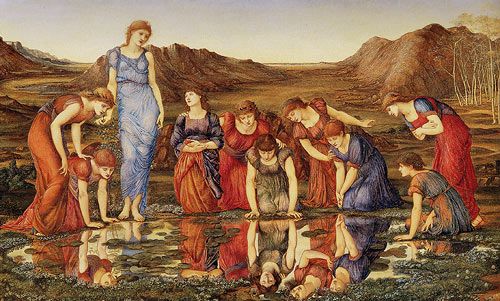
If the Forbes family is reduced to selling off their priceles Pre-Raphaelite treasures, what does that mean for the rest of us?
The family is in the process of selling a trove of art treasures from their London home for an estimated £5million. The collection included several pieces by prominent Pre-Raphaelites Sir Edward Burne Jones and Sir John Everett Millais. Two of Millais' paintings, 'For The Squire' and 'Trust Me,' were on sale for £850,000.00 each, while Sir Edward Burne-Jones' spectacular 'Mirror Of Venus'(shown above) was on offer for $500,000.
Read more at The Evening Standard.
Image courtesy Wikimedia commons
Posted by
Margaret
at
9:07 PM
6
comments
![]()
![]()
Labels: edward burne-jones, millais, news, pre-raphaelites
Thursday, November 27, 2008
Priceless Pre-Raphaelite Painting Found in Dusty Attic
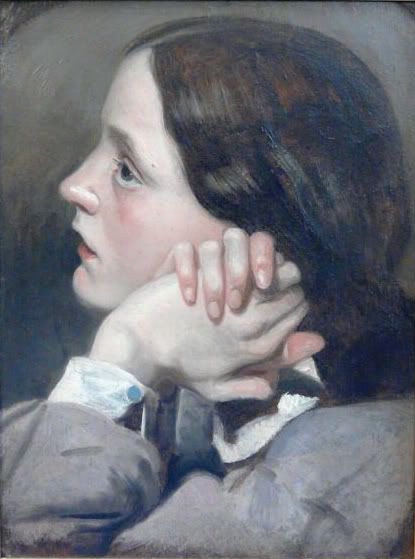
A woman in Somerset, England, recently discovered this rare portrait by John Everett Millais of his wife, Effie Millais, while she was in the process of cleaning her house.
How come stuff like this never happens to me?
Apparently, she had received the painting as a birthday gift when she was just nine years old (now that was one spoiled child!), and then forgot about it. The man who was evaluating the rest of her belongings, Duncan Chilcott, described his discovery:
"Up in the attic she wanted me to look at a table. On the other side of the room behind some old mattresses I saw the painting leaning against the wall," the Telegraph quoted him as saying.
"It was covered in thick dust and I was astonished when I blew it off and saw what was beneath."
"The lady selling it said it was purchased for her by her mother as a ninth birthday present."
Mr. Chilcott's wife later added that when the woman was informed of the painting's value, she was rather nonplussed:
"she wasn't leaping up and down but she was surprised by it. I guess it is cash in the attic for her."Perhaps her mother would have been better off getting her a bicycle for her birthday and keeping the fine art for herself.
While the owner might not be excited about the paintings' discovery, the art world is quite excited. You will recall that Effie Millais was actually married to the art critic John Ruskin before she met Millais. Because Effie's hand is hidden in this portrait, there is some speculation that it has something to do with John and Effie's relationship (or, as the Daily Mail more provocatively stated it, the "scandal of a love triangle"). The painting will be auctioned on December 9.
Read the whole story at the Daily Mail
Posted by
Margaret
at
7:10 PM
10
comments
![]()
![]()
Labels: millais, news, pre-raphaelites, ruskin
Tuesday, September 23, 2008
The Original Members of the Pre Raphaelite Brotherhood
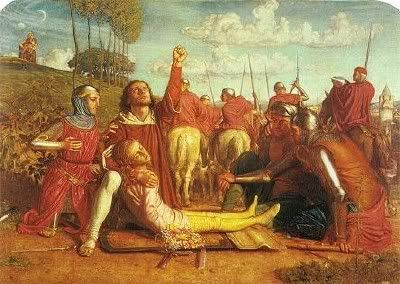
Last week I wrote a post about the Pre-Raphaelite that led to some questions about the original Pre-Raphaelite Brotherhood. I thought today I would write a little bit about the founding members of the PRB, and the major players among them.
Although there were seven original members of the Pre-Raphaelite Brotherhood, the founding members of the Brotherhood were really Dante Gabriel Rossetti, William Holman Hunt and John Everett Millais. These three have had the most lasting influence from among the original seven, and there work is the best known. After the idea for the PRB had been developed by Rossetti, Hunt and Millais, Rossetti invited his brother William, a clerk at the Inland Revenue Office, into the group as well. Interestingly, at the time the the Brotherhood was founded, William was neither a painter nor a serious writer. Nevertheless, he was the founding member's brother, and I suppose you can't blame Rossetti for wanting to include his family members!(Christina Rossetti was also an important part of the group, though she was excluded from the Brotherhood by reason of her sex).
Thomas Woolner, the fifth member of the PRB, was a sculptor who was introduced to the Brotherhood by D.G. Rossetti. In his biography of Rossetti, Evelyn Waugh is anxious to point out that Thomas Woolner married a Waugh (Alice Waugh). So too, did William Holman Hunt--twice. He first married Fanny Waugh, and when she died in childbirth, he married her sister, Edith. This was illegal in Britain at the time and he had to travel abroad in order to marry her!(Waugh, 35). No wonder Waugh was so interested in the Pre-Raphaelites!
James Collinson, a convert to Roman Catholicism had torrid on again/off-again relationships with both Christina Rossetti and the Catholic Church--both of which often seemed to hold far more interest to him than his painting--was the next to join. Frederick George Stephens was the seventh and final member of the original group. Stephens was a student of William Holman Hunt and his membership in the Brotherhood may have been due as much to Rossetti's superstition (a desire for a perfect seven-member group) as to any supposed artistic contribution from Stephens.
Source consulted: Evelyn Waugh. Rossetti, His Life and Works. London: The Folcraft Press, 1969.
Image: William Holman Hunt, Rienzi Vowing to Obtain Justice
Posted by
Margaret
at
4:58 PM
5
comments
![]()
![]()
Labels: millais, pre-raphaelites, rossetti, william holman hunt
Tuesday, September 16, 2008
Millais' Pizarro Seizing the Inca of Peru
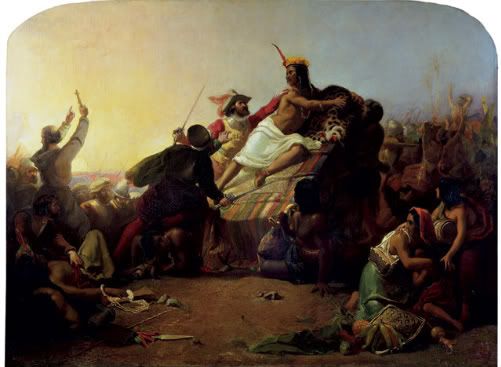
"Pizarro Seizing the Inca of Peru" is another of Millais' early masterpieces. He was just 16 when it was completed! The painting features Atahualpa, the last sovereign leader of the Inca empire, being seized by the conquistador Francisco Pizarro. It's the only painting by Millais that I know of that is set in Latin America. Unlike his self portrait, it shows more of the fine detail that would become a hallmark of his later work.
The exhibition catalogue at the Tate arguest notes that pyramidal organization of the figures, baroque lighting and "groups of huddled women and children derive from religious pictures of the Renaissance and later neoclassical and Romantic history paintings"(Tate). I like the inclusion of the pineapple and plantain in the foreground of the painting--I wonder if Millais had ever tasted them, or if his mother had just found a picture of them in the British Museum?
One of the things that struck me most about this painting was the large role that Millais' family played in helping him prepare for it. His mother, Mrs. Millais spent hours in the British Museum Reading-Room researching the historical details for the picture (the textiles are actually fairly accurate, which surprised me). She also handmade all of the clothing for the models! Mrs. Millais would also entertain her son by reading to him while he painted, and her husband offered his assistance by posing in a variety of wigs for his son's paintings.
The Millais family loved helping their young son John with his paintings, although their constant involvement got on Millais' nerves at times. It bothered him that they called him "Johnny" when he was older, and they had a bad habit of using his studio as a living room. Waugh tells a great story in his biography of Rossetti about Millais' struggle for independence:
Rebellion was in the air in 1848, and one afternoon in early spring Mrs. Millais found the studio door locked against her. Inside, Holman-Hunt was lecturing Millais on the decadence of English painting.
Later in the evening the family became reconciled. Hunt and Millais went into the parlour to visit "the old people." Mrs. Millais sat crocheting in the armchair. Her needle clicked intently and the boys' entrance was allowed to pass unnoticed. Millais advanced into the room, swaggering ever so little; Hunt hung back rather ill at ease.
"Now, we've come to have a nice time with you, mama and papa," he said jauntily.
His mother hardly looked up from her work.
"We do not wish to tax your precious time. We have our own occupations to divert us and engage our attention!"
But Millais was not easily snubbed, as many people learned later.
"Hoity-toity, what's all this?" he cried affectionately, pressing a guitar into his father's hand. "Put down your worsted, amam, I'm going to play back-gammon with you directly."(Waugh, 31-32)
All was forgiven after the game of back-gammon, but it seems that Millais' parents tried to give their young son a little more artistic space afterwards. Millais' studio was left in peace, though his parents were still actively involved in helping him with his work.
Evelyn Waugh. Rossetti: His Life and Works. London: The Folcroft Press, 1969.
Image courtesy Tate Gallery
Posted by
Margaret
at
7:47 AM
13
comments
![]()
![]()
Labels: millais, pre-raphaelites
Monday, September 15, 2008
Millais Self-Portrait
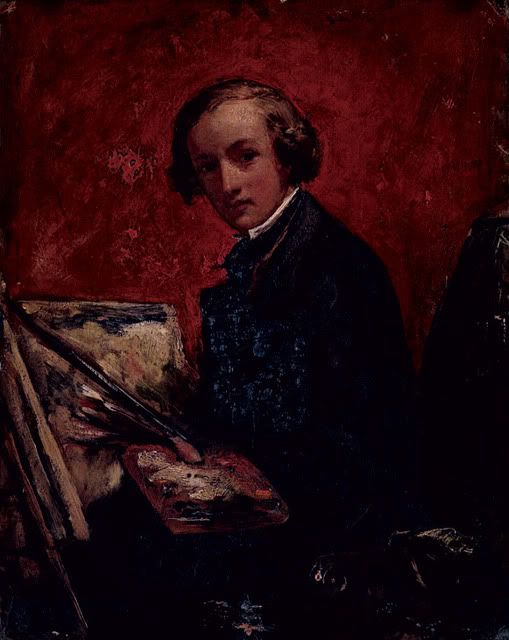
John Everett Millais painted this self-portrait when he was just 18 years old. He had already been a member of the Royal Academy of Art Schools for 7 years, having been admitted at the age of 11 (he remains the youngest person ever admitted to the Schools).
Millais' self-portrait was painted just two years before he helped found the Pre-Raphaelite Brotherhood, but the style of the painting seems light years away from the fine detail evident in Lorenzo and Isabella. I have to admit that if I didn't know who had painted this portrait, I would have had a hard time guessing who it was! Perhaps Millais was experimenting with new techniques when he created this portrait, because the brushwork seems much for "sloshy" than in his later work--or even than in his earlier work.
Tomorrow: a story from Millais' youth, and a closer look at one of his earliest masterpieces, Pizarro Seizing the Inca of Peru.
image courtesy of Tate Gallery
Posted by
Margaret
at
10:16 AM
10
comments
![]()
![]()
Labels: millais, william holman hunt
Thursday, September 11, 2008
John Everett Millais' Mariana
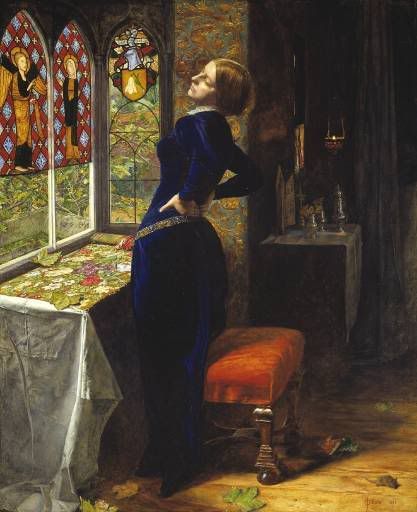
For myself, one of the most enduring appeals of Pre-Raphaelite art is its strong relationship to romantic literature. Millais' 1851 work, Mariana, is a great example of this. The painting is based on a poem of the same title by Tennyson that in turn was inspired by Shakespeare's play, Measure for Measure. In Measure for Measure, the character Mariana is abandoned by her fiance, Angelo, when her dowry is lost in a shipwreck.
Millais' illustration of Mariana at the window reminds me of other stories, such as that of Penelope. Like Penelope, Mariana is engaged in needlework. Autumn leaves have blown in through the window and are scattered about the room--on the floor as well as on her needlework project, which the gallery description at the Tate suggests represents "the burden of her yearning as time passes." She is staring at a stained-glass image of the annunciation, which according to Tim Barringer was seen "as a quasi-sexual event" for both Millais and Rossetti in their paintings (42-43). There definitely is an undercurrent of frustration and longing in the painting.
Millais originally exhibited the painting along with several lines from Alfred Lord Tennyson's poem, Mariana:
She only said, 'My life is dreary,
He cometh not,' she said;
She said, 'I am aweary, aweary,
I would that I were dead!'
Tomorrow: another Pre-Raphaelite vision of Mariana.
image courtesy Tate Gallery
Source consulted: Tim Barringer. The Pre-Raphaelites. London: Everyman Art Library, 1998
Posted by
Margaret
at
11:18 AM
16
comments
![]()
![]()
Labels: millais, needlework, poetry, pre-raphaelites, shakespeare, tennyson
Tuesday, July 22, 2008
Christ in the House of His Parents, Sir John Everett Millais

Christ in the House of His Parents was first exhibited by John Everett Millais at the Royal Academy in 1850 when he was was just 20 years old. The work was accompanied by a quote from Zechariah 13:6 "And who shall say unto him, What are these wounds in thine hands? Then he shall answer, Those with which I was wounded in the house of my friends."
The symbolism in this painting is particularly rich. Furthermore, because the story of Christ is well-known by most viewers, it's quite easy to analyse the painting. It is evident a young Jesus has somehow injured his hand after trying to remove a nail from the door on the work table with the pliers (some of his blood is visible on the door). The blood from the wound in his hand has also trickled onto his foot, foreshadowing the crucifixion. We can see his cousin John (the Baptist), on the right bringing him water to wash his wound--prefiguring, of course, Christ's baptism. Behind Christ's head at the top of the ladder in the background you can also see a dove, symbolising the Holy Spirit. Immediately above his head are Joseph's carpenter tools, suggesting the "crown of thorns" and representing the tools of his crucifixion.
Millais has placed an unfinished basket in the left foreground, signifying the work the remains to be done in Jesus' life. In the right background you can see a candle burning in the window, representing time. I also loved the way that Millais set up a cross pattern behind the young Jesus. By placing Christ in the centre of the painting, the worktable forms a cross with his body. Then, above his head you can see a cross formed out of the crack in the wall and the end of the saw. Can you see it?
The painting elicited a strong reaction among critics. Charles Dickens was deeply offended by the stark realism of the work, which he considered ugly and blasphemous (Blackwood's Magazine reacted similarly). Moreover, with its emphasis on child baptism and the necessary separation between the church (Christ and his family) and the laity (persons who are not clergy--depicted in the painting as the penned sheep). Nevertheless, despite whatever theological objections Ruskin had to the work, he continued to defend Millais against the critics, saying "Millais first showed me the beauty of extreme minuteness and precision."
Works consulted: Robert Hewison. Ruskin, Turner and the Pre-Raphaelites. London: Tate Gallery Printing, 2000, 30.
Posted by
Margaret
at
9:45 AM
3
comments
![]()
![]()
Labels: millais, pre-raphaelites
Wednesday, July 16, 2008
Lorenzo and Isabella by Sir John Everett Millais
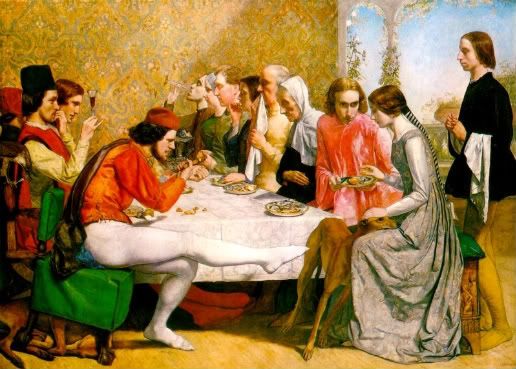
The first painting by Sir John Everett Millais to include the initials "P.R.B." was Lorenzo and Isabella, first exhibited at the Royal Academy in 1849 along with Holman Hunt's Rienzi. If you look closely, you will see the Pre-Raphaelite Brotherhood's distinctive monogram displayed on the leg of Isabella's stool.
The painting is based on Keat's poem "Isabella, or, the Pot of Basil." The poem tells the story of Isabella and Lorenzo falling in love. After their affair, her jealous brothers murder Lorenzo. When Isabella finds his body she removes his head, which she promptly deposits in a pot. She then sets to growing basil in the pot. It's a rather sordid and excessively dramatic tale, originally taken from Boccaccio. It's not that surprising that Keats chose this subject matter though--he was a mere 19 years old when he wrote the poem!
Lorenzo and Isabella is remarkably detailed and demonstrates the tremendous promise Millais showed as an artist (he was only 20 years old!). I am particularly fond of the faces in this painting, many of which were based on well known associates of the Brotherhood. Dante Gabriel Rossetti can be seen drinking on the right hand side of the table. His brother William Rossetti is Lorenzo (seen passing the fruit to Isabella). Millais' sister in law is posing as Isabella. The man whose face is visible on the back lefthand side is Walter Deverell. The man kicking the dog was actually John Harris, a man who had bullied Millais when he was in school!(Hawksley, 20).
Source consulted: Lucinda Hawksley, The Essential Pre-Raphaelites.
Image courtesy The Rossetti Archive.
Posted by
Margaret
at
7:27 AM
5
comments
![]()
![]()
Labels: millais, pre-raphaelites


